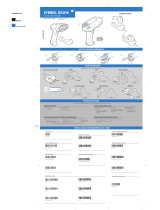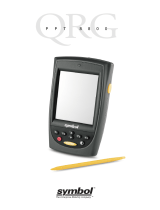
Quick Reference Guide 11
Symbol Rechargeable Batteries
Symbol rechargeable battery packs are designed and constructed to the highest standards within the
industry. However, there are limitations to how long a battery can operate or be stored before needing
replacement. Many factors affect the life of a battery pack such as heat, cold, customer usage
profiles, age, and severe drops.
When batteries are stored over a year, battery cell manufacturers advise that some irreversible
deterioration in overall battery quality may occur. To minimize this loss, they recommend storing
batteries half charged in a dry, cool place between 41° and 77°F (5° and 25°C), the cooler the better)
and removed from the equipment to prevent the loss of capacity. Batteries should be charged to half
capacity at least once a year. If an electrolyte leakage is observed, avoid any contact with the
affected area and properly dispose of the battery.
Replace the battery when a significant loss of run time is detected. Batteries must be charged within
the 32° to 104°F (0° to 40°C) temperature range.
The standard warranty period for all Symbol batteries is 30 days, regardless if the battery was
purchased separately or included as part of the mobile computer. For more information on Symbol
batteries, please visit http://mysymbolcare.symbol.com/battery/batbasics1.html.
Radio Frequency Interference Requirements-FCC
Note: This equipment has been tested and found to comply with the limits for a
Class B digital device, pursuant to Part 15 of the FCC rules. These limits are
designed to provide reasonable protection against harmful interference in a
residential installation. This equipment generates, uses and can radiate radio
frequency energy and, if not installed and used in accordance with the instructions, may cause
harmful interference to radio communications. However there is no guarantee that interference will
not occur in a particular installation. If this equipment does cause harmful interference to radio or
television reception, which can be determined by turning the equipment off and on, the user is
encouraged to try to correct the interference by one or more of the following measures:
- Reorient or relocate the receiving antenna.
- Increase the separation between the equipment and receiver.
- Connect the equipment into an outlet on a circuit different from that to which the receiver is
connected.
- Consult the dealer or an experienced radio/TV technician for help.
Radio Transmitters (Part 15)
This device complies with Part 15 of the FCC Rules. Operation is subject to the following two
conditions: (1) this device may not cause harmful interference, and (2) this device must accept any
interference received, including interference that may cause undesired operation.
Radio Frequency Interference Requirements - Canada
This Class B digital apparatus complies with Canadian ICES-003.
Cet appareil numérique de la classe B est conforme à la norme NMB-003 du Canada.
Radio Transmitters
This device complies with RSS 210 of Industry & Science Canada. Operation is subject to the
following two conditions: (1) this device may not cause harmful interference and (2) this device must
accept any interference received, including interference that may cause undesired operation.
Label Marking: The Term "IC:" before the radio certification only signifies that Industry Canada
technical specifications were met.
Tested to comply
with FCC Standards
FOR HOME OR OFFICE USE


















